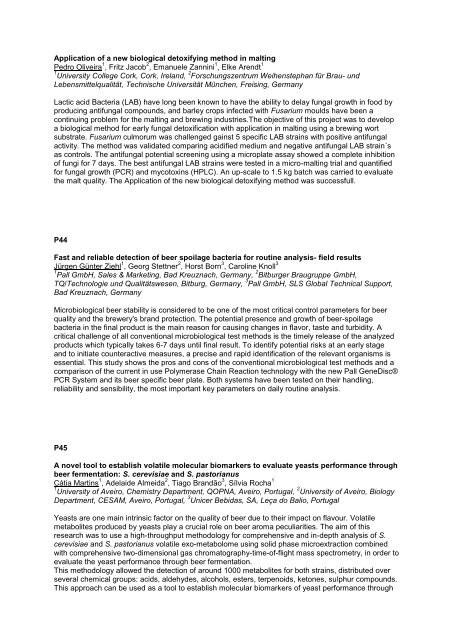here - the 34th European Brewery Convention
here - the 34th European Brewery Convention
here - the 34th European Brewery Convention
Create successful ePaper yourself
Turn your PDF publications into a flip-book with our unique Google optimized e-Paper software.
Application of a new biological detoxifying method in malting<br />
Pedro Oliveira 1 , Fritz Jacob 2 , Emanuele Zannini 1 , Elke Arendt 1<br />
1 University College Cork, Cork, Ireland, 2 Forschungszentrum Weihenstephan für Brau- und<br />
Lebensmittelqualität, Technische Universität München, Freising, Germany<br />
Lactic acid Bacteria (LAB) have long been known to have <strong>the</strong> ability to delay fungal growth in food by<br />
producing antifungal compounds, and barley crops infected with Fusarium moulds have been a<br />
continuing problem for <strong>the</strong> malting and brewing industries.The objective of this project was to develop<br />
a biological method for early fungal detoxification with application in malting using a brewing wort<br />
substrate. Fusarium culmorum was challenged gainst 5 specific LAB strains with positive antifungal<br />
activity. The method was validated comparing acidified medium and negative antifungal LAB strain´s<br />
as controls. The antifungal potential screening using a microplate assay showed a complete inhibition<br />
of fungi for 7 days. The best antifungal LAB strains were tested in a micro-malting trial and quantified<br />
for fungal growth (PCR) and mycotoxins (HPLC). An up-scale to 1.5 kg batch was carried to evaluate<br />
<strong>the</strong> malt quality. The Application of <strong>the</strong> new biological detoxifying method was successfull.<br />
P44<br />
Fast and reliable detection of beer spoilage bacteria for routine analysis- field results<br />
Jürgen Günter Ziehl 1 , Georg Stettner 2 , Horst Born 3 , Caroline Knoll 3<br />
1 Pall GmbH, Sales & Marketing, Bad Kreuznach, Germany, 2 Bitburger Braugruppe GmbH,<br />
TQ/Technologie und Qualitätswesen, Bitburg, Germany, 3 Pall GmbH, SLS Global Technical Support,<br />
Bad Kreuznach, Germany<br />
Microbiological beer stability is considered to be one of <strong>the</strong> most critical control parameters for beer<br />
quality and <strong>the</strong> brewery's brand protection. The potential presence and growth of beer-spoilage<br />
bacteria in <strong>the</strong> final product is <strong>the</strong> main reason for causing changes in flavor, taste and turbidity. A<br />
critical challenge of all conventional microbiological test methods is <strong>the</strong> timely release of <strong>the</strong> analyzed<br />
products which typically takes 6-7 days until final result. To identify potential risks at an early stage<br />
and to initiate counteractive measures, a precise and rapid identification of <strong>the</strong> relevant organisms is<br />
essential. This study shows <strong>the</strong> pros and cons of <strong>the</strong> conventional microbiological test methods and a<br />
comparison of <strong>the</strong> current in use Polymerase Chain Reaction technology with <strong>the</strong> new Pall GeneDisc®<br />
PCR System and its beer specific beer plate. Both systems have been tested on <strong>the</strong>ir handling,<br />
reliability and sensibility, <strong>the</strong> most important key parameters on daily routine analysis.<br />
P45<br />
A novel tool to establish volatile molecular biomarkers to evaluate yeasts performance through<br />
beer fermentation: S. cerevisiae and S. pastorianus<br />
Cátia Martins 1 , Adelaide Almeida 2 , Tiago Brandão 3 , Sílvia Rocha 1<br />
1 University of Aveiro, Chemistry Department, QOPNA, Aveiro, Portugal, 2 University of Aveiro, Biology<br />
Department, CESAM, Aveiro, Portugal, 3 Unicer Bebidas, SA, Leça do Balio, Portugal<br />
Yeasts are one main intrinsic factor on <strong>the</strong> quality of beer due to <strong>the</strong>ir impact on flavour. Volatile<br />
metabolites produced by yeasts play a crucial role on beer aroma peculiarities. The aim of this<br />
research was to use a high-throughput methodology for comprehensive and in-depth analysis of S.<br />
cerevisiae and S. pastorianus volatile exo-metabolome using solid phase microextraction combined<br />
with comprehensive two-dimensional gas chromatography-time-of-flight mass spectrometry, in order to<br />
evaluate <strong>the</strong> yeast performance through beer fermentation.<br />
This methodology allowed <strong>the</strong> detection of around 1000 metabolites for both strains, distributed over<br />
several chemical groups: acids, aldehydes, alcohols, esters, terpenoids, ketones, sulphur compounds.<br />
This approach can be used as a tool to establish molecular biomarkers of yeast performance through





